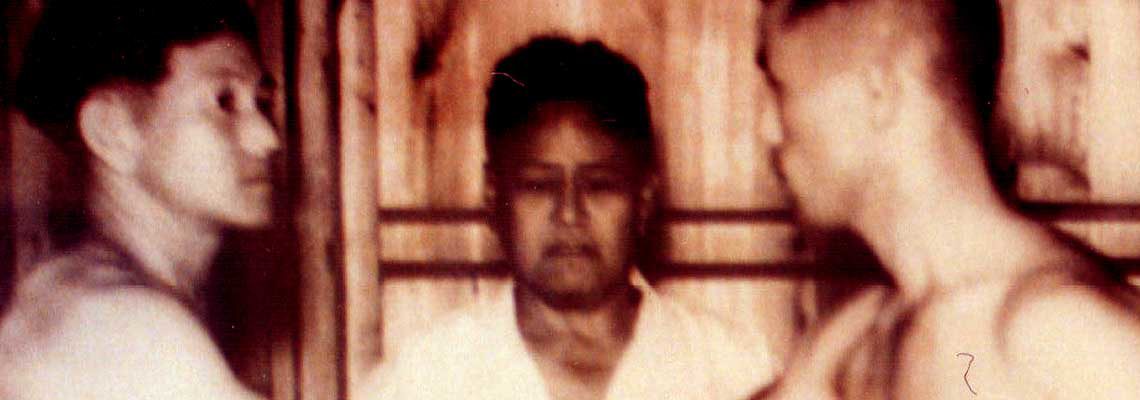by Sean Wong
March 26, 2013
 Chojun Miyagi (宮城 長順) was born on April 25th, 1888; which was about 10 years after the end of the Satsuma occupation of Okinawa. He grew up in Higashimachi, Naha, Okinawa. At a young age, he witnessed an assailant being captured by a man who, in comparison to the troublemaker, seemed deceptively frail. The man’s name was Ryuko Arakaki. Young Miyagi followed Arakaki to seek his tutelage in combat knowledge. It was with Arakaki that Chojun Miyagi strengthened his body using the old Okinawan implements of Nigiri Game, Chishi, etc… Two years later, Arakaki formally introduced Miyagi to Kanryo Higaonna.
Chojun Miyagi (宮城 長順) was born on April 25th, 1888; which was about 10 years after the end of the Satsuma occupation of Okinawa. He grew up in Higashimachi, Naha, Okinawa. At a young age, he witnessed an assailant being captured by a man who, in comparison to the troublemaker, seemed deceptively frail. The man’s name was Ryuko Arakaki. Young Miyagi followed Arakaki to seek his tutelage in combat knowledge. It was with Arakaki that Chojun Miyagi strengthened his body using the old Okinawan implements of Nigiri Game, Chishi, etc… Two years later, Arakaki formally introduced Miyagi to Kanryo Higaonna.
Among Miyagi’s peers were Juhatsu Kyoda, Jinan Shinzato, and Seiko Higa. At this time, Karate was still practiced in secrecy. Higaonna trained and taught in the city of Naha while his contemporary, Anko Itosu, made a name for himself in Shuri. In time Miyagi developed and grew into a respected martial artist. When Higaonna had fallen ill, he was, unfortunately, living in solitude since the passing of his wife. Miyagi took him in and took final hospice care of his Sensei. After Higaonna’s passing, Miyagi’s passion to continue learning led him to China to follow in the footsteps of his teacher. Upon his return, he waited for several years before teaching.
Around 1926, Miyagi became one of the main instructors for Okinawa’s first publicly sanctioned dojo called the Okinawa Karate Kenkyu Club. It was a garden dojo shared by several notable instructors at the time. These were Chojun Miyagi, Chomo Hanashiro, Choyu Motobe, and Kenwa Mabuni. Students were free to pick and choose who they wish to train with. A year later, however, the dojo closed, perhaps due to mismanagement. Miyagi’s students followed him to his garden dojo. Miyagi didn’t seem to use makiwara much. Although some people used Naha-te to define Miyagi’s system, Dai Sensei recalls it commonly known as tode (China Hand). Chojun Miyagi primarily taught Yobi Undo, Hojo Undo, and Kihon Kata (Sanchin) while other teachers were teaching popular Kaishu kata. It was probably why he had only a handful of students. It wasn’t uncommon for Chojun Sensei to ask students to dig out a tree or to move heavy objects and then conclude class with a lecture.
Training under Miyagi was sometimes severe. Whenever students went to the public bathhouse, it was easy to tell who was Chojun Miyagi’s students due to the welts on the shoulders from the cuffing of Sanchin testing. Miyagi’s belief was that a lion throws his offsprings from a cliff to see who would survive. Miyagi wanted only the strongest to be his students.

This memorial is in Matsuyama Park beside the school where Chojun Miyagi once taught. The location is about a 5-minute walk from the Meibukan Hombu Dojo.
Interest in Karate was becoming popular in university cities like Tokyo and Kyoto and many Okinawan teachers left to teach there including, Kenwa Mabuni, Juhatsu Kyoda, and Gichin Funakoshi. Chojun Miyagi remained in Okinawa where he worked as a teacher and to promote Karate as an Okinawan contribution to Japanese budo. Chojun Miyagi Sensei led a committee, sanctioned by the board of education, to create a unified kata for all of Okinawa Karate. The committee included Shoshin Nagamine Sensei. The formation created what is now known as Fugyugata 2 in Shorin Ryu and Geki Sai 1 in Goju-Ryu. The kata combines both Shuri-te and Naha-te basic techniques. Miyagi’s further efforts would lead to Karate’s acceptance into the Dai Nippon Butoku Kai and taught throughout Japan as an alternative to Judo.
In 1952, he created the Goju Ryu Preservation Society with Yagi Meitoku Dai Sensei, Miyazato Eichi Sensei, Toguchi Seikichi Sensei, and Higa Seiko Sensei as members. Sadly, in 1953, Chojun Miyagi passed away suddenly. Upon his passing, Miyagi did not leave an heir. Dai Sensei, along with Toguchi Sensei, sought the advice of Juhatsu Kyoda (in Tokyo) who was Miyagi Sensei’s peer under Kanryo Higaonna. The advice was to determine who should be the successor to Chojun Miyagi and Goju-Ryu. Dai Sensei requested if Kyoda Sensei himself would consider taking on this important position. Kyoda Sensei proposed that if the name was changed from Goju-Ryu to To’on Goju-Ryu, he would consider it. Upon Dai Sensei’s return, it was discussed among the Goju-Ryu group and they collectively declined the proposal. Even today, the Goju-Ryu community at large still cannot come to a conclusion of succession. However, in 1963, Miyagi’s family awarded Yagi Meitoku the grand master’s uniform and belt with the blessing as successor.
Chojun Miyagi left behind a legacy of Okinawa culture for the world to enjoy. Of all of the unique aspects of Okinawa’s heritage such as language, music, and dance, Karate is by far the most accepted worldwide. Today, many of his students have become famous for Goju-Ryu karate. These masters include Toguchi Seikichi, Miyazato Eichi, Higa Seiko, Yamaguchi Gogen, and Yagi Meitoku.
The primary source of information from this article is from “The Life Drama of the Man – Meitoku” by YAGI Meitoku and from “From Father to Son – The Meibukan Legacy” by YAGI Meitetsu.
copyrights 2013 Sean Wong, All rights reserved.
